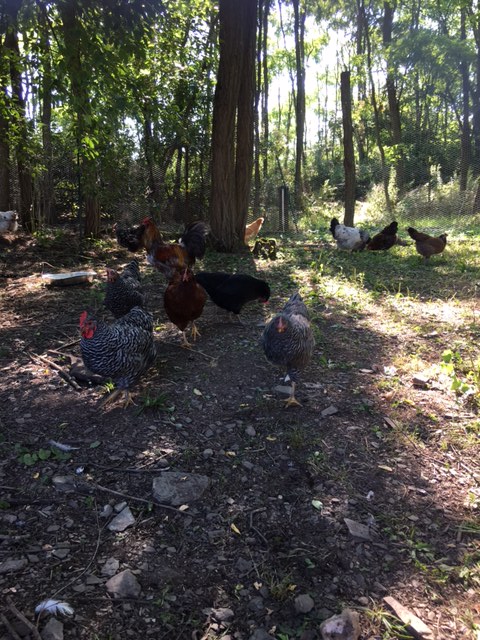Free Range Poultry, the Inside Scoop

A hen lounges in the grass soaking in the sun, on her side with her wing partially open.
The rooster pecks, watches, pecks, watches, then circles the flock, always on alert.
A pullet scoots through a cluster of hens after a grasshopper, scolded by one of the older ones.
Just a snapshot of the flock dynamics from a few minutes watching chickens in a large run or while free ranging.
If you enjoy this view like I do, free ranging or pasturing chickens is a pleasant way to raise your flock. The added food the hens or broilers pick up while foraging can help save on your overall costs, once fencing and predator prevention has been paid for.
When considering nutrition for free range or any poultry, first consider your overall goals.
- Are you raising for meat or eggs?
- Are you working to maximize egg production, size and eggshell quality?
- Do you have a flock for eggs and perhaps meat for your family and enjoy watching the flock more than you care about the number of eggs you collect?
- Are you rotating your flock maximize the nutrition from the pasture?
- What are your winters like and do you expect egg production in the cold seasons?
Your answers determine your nutrition program for your flock.
Pastured or free range chickens pick up as much nutrition as the pasture has to offer, until they are full that day.
If you have ever built a new run, delighted at the lush green grass and plants as you let your chickens out the first few days, only to be horrified at the decimation they caused in a short time, you understand how completely chickens will take advantage of the food sources in an area.
Here’s where the old adage, you are what you eat, comes in. Chickens will get the nutritional value of what they are foraging on.
So, if they are free ranging on a fairly well-manicured lawn, the variety of species of plants and insects is quite limited. If they are being rotated weekly within an electric netting fence in a large field that’s mowed twice per year, housed out of a chicken tractor or hoop house, the variety will be much wider.
No matter where you raise your poultry, their nutritional needs are pretty much the same.
They’re all individuals, just like us, so one hen may need more calcium, for example, than another to keep the same eggshell quality as another hen
Whenever we take away feeding consistency, we change what we know the poultry are receiving as far as nutrition.
So, you can change how much nutrition they are getting, but their needs are the same. Whenever these needs for calories, vitamins, minerals and amino acids are not met, a bird will have a deficiency which can cause health issues.
These health issues can range from minor to severe; from dull colored feathers and poor feather regrowth after molt or hen pecking, to decreased immune system that leads to susceptibility to respiratory infections.
So, does this mean you cannot raise your poultry out in nature with a varied diet? Absolutely not!
Just keep in mind that the commercial feed and supplements that you’re feeding are that much more important because your birds are consuming a much smaller amount of them. For example, a chicken’s diet in a coop and small run is 90% layer feed, like Nutrena® NatureWise® Layer Pellets, and 10% a combination of scratch, calcium chips, unlucky insects that wander in and vegetable scraps.
Since 90% of the hen’s diet is balanced for egg production, feather quality and overall health, the hen is healthy and produces large, thick-shelled eggs.
If we take the same hen, open the coop door and let her free range from 7am-7pm, the percentage of the layer feed she eats will dramatically decrease.
Let’s say now 80% of her diet is free ranging, and 20% is layer pellets. Now, keep in mind, depending on where the flock is going, she can eat some yummy and nutritious things like insects, worms, frogs, all sorts of plants, flowers, vegetables, even mice.
None of this is bad for her, chickens are omnivores and meant to eat all these things. The result we may see is that since the hen is not eating very much layer pellet, she may be deficient in vitamins, minerals or amino acids if she is not getting those from her environment.
Think about it like your diet. If you are eating three balanced meals a day, you’re most likely getting everything your body needs. If you are on the run and your meals are unbalanced and inconsistent, you may need to add a multivitamin, protein shake, meal bar or other supplement to prevent a deficiency.
So, give your free range hens a concentrated diet in addition to their free ranging and you will ensure that they get everything that they need in the smaller amount of feed they eat.
For example, Nutrena® Country Feeds® Egg Producer is a concentrated formula that is high in energy, amino acids, vitamins and minerals that hens need to stay healthy and lay beautiful eggs for your family or customers.
This type of feed is also helpful if you’re mixing in whole grains, fermented feed, compost or large amounts of vegetable scraps from your kitchen. It’s like giving hens all the amino acids, vitamins and minerals they need in a small amount like a meal/energy bar that we humans would eat.
Use nutrition as preventative medicine to keep your hens healthy and laying. And keep enjoying the sight of your flock and their antics outside!
